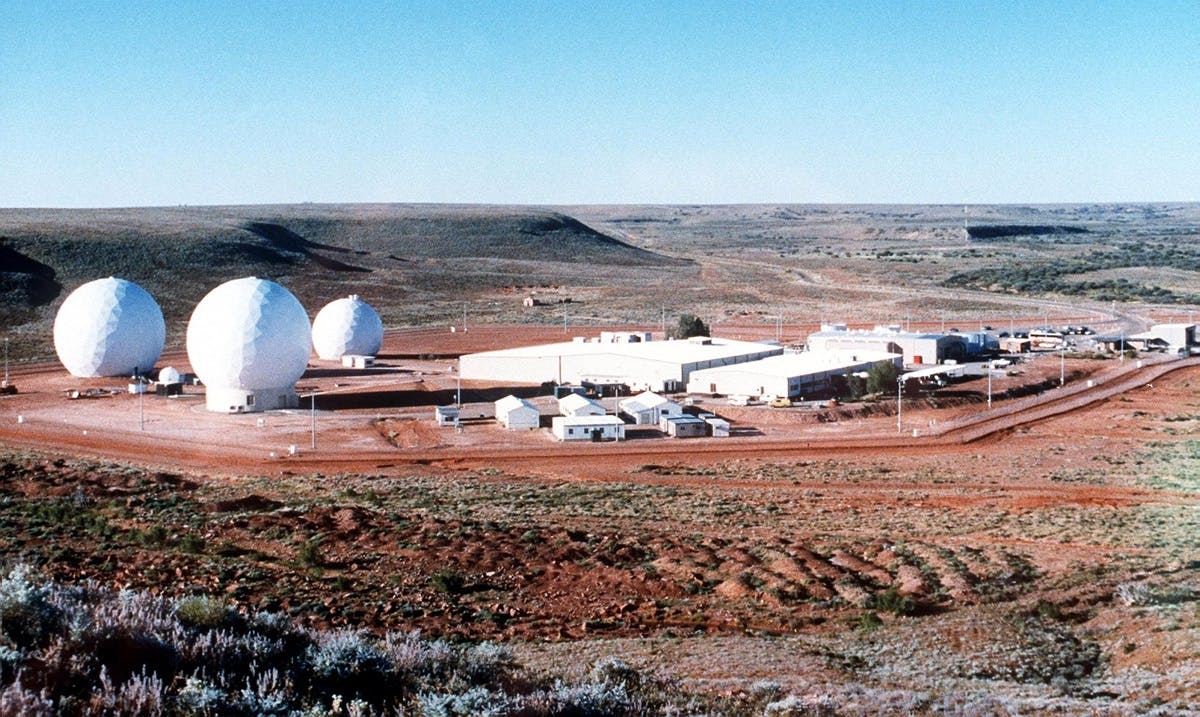Pine Gap: Australia’s secret and deadly weapon

From nuclear submarines and high-profile defence pacts to politicians fawning over “our best friends”, the Australian government’s support for US empire is far from secret. But the single most important contribution Australia makes to the alliance is much more opaque.
The Pine Gap defence facility is located eighteen kilometres south-west of Alice Springs. Launched by a US-Australia treaty in 1966, it is home to more than 30 radio domes and antenna systems. The facility is primarily managed by American intelligence organisations the CIA and the National Security Agency (NSA), and it has around 800 employees, half of whom are Australian.
That’s about as much as either government has ever publicly disclosed about Pine Gap.
Approaching the facility will get you arrested, fined and potentially jailed. Only twice have people been charged under the Defence Special Undertaking Act 1952, a draconian piece of Cold War legislation that carries a jail sentence of up to seven years and requires the approval of the attorney-general to be invoked. Both times were against activists protesting at Pine Gap.
Almost everything we know about Pine Gap comes from whistleblowers and military experts.
The basics of its operations are as follows. Satellites operated out of Pine Gap are positioned across the Eastern Hemisphere, particularly within range of China, Russia and the Middle East. They intercept a vast range of signals: phone calls, radio waves, heat generated by missile launches and more. Pine Gap decodes the signals and turns them into intelligence, allowing the US and Australia to spy on their current and potential enemies and plan military operations.
For more than 50 years, Pine Gap has been an indispensable cog in the Western military machine, “perhaps the most important United States intelligence facility outside that country”, according to expert Richard Tanter.
Pine Gap was key to US nuclear war planning during the Cold War. Intelligence from the base was used for the carpet bombing of Cambodia, which killed hundreds of thousands of people during the Vietnam War. Documents leaked by Edward Snowden in 2013 revealed Pine Gap was at the heart of America’s drone strike campaigns in Pakistan, the Middle East and North Africa.
The base has also been an important source of information for Israel. In 1973, Pine Gap intelligence helped Israel make key military breakthroughs in its war with a coalition of Arab states. David Rosenberg, a former high-ranking employee of the NSA who worked at Pine Gap for eighteen years, told Declassified Australia in November, “Pine Gap facility is monitoring the Gaza Strip and surrounding areas with all its resources, and gathering intelligence assessed to be useful to Israel”.
We will never know how many Palestinians, Cambodians, Pakistanis and others had their death warrants written in the Northern Territory desert.
While it has already contributed much to American military dominance, Pine Gap could play an even greater role in a future war with China. The site is central to Western surveillance of China, according to Richard Dearlove, a former British spy chief. Its location and technical capabilities make it an unparalleled asset for any Western assault in East Asia.
Some critics of Pine Gap see it as an example of Australia being duped by the US—there are even rooms that Australians can’t enter!
“Do they realise how much of our sovereignty we have passed on to the US with Pine Gap?”, railed former diplomat Bruce Haigh in 2020. “What are we doing? What have we been conned into?”
But Australia’s rulers know exactly what they’re doing; Pine Gap plays an important role in strengthening Australian imperialism.
For one, the facility is undoubtedly used to aid Australia’s own foreign interests and interventions. This country is no stranger to spying. For example, in 2004, Australia bugged the offices of the East Timorese prime minister while negotiating over oil and gas deposits. It’s not hard to see how access to the best military intelligence technology in the world could be of use to the politicians and generals in Canberra.
More importantly, Pine Gap has integrated Australia into the network of US military power that dominates the Asia-Pacific. Australian leaders recognise that being intertwined with the world’s greatest superpower helps to boost their own economic, political and military weight through association. Hosting Pine Gap is probably the most significant leverage Australia has within the alliance.
But what’s good for the Australian ruling class is life-threatening for the rest of us. Pine Gap could become a key target for China or another power at war with the US, dragging that conflict to the Northern Territory.
Politicians have long been aware of this threat. A 1980 report commissioned by the Fraser government found that in the event of a war with the USSR, “nuclear attacks on [the Pine Gap] facilities would probably occur”. Former Labor leader Kim Beazley admitted in 1996, “[W]e accepted that the joint facilities were probably targets, but we accepted the risk of that for what we saw as the benefits of global stability”.
Pine Gap is one of Australia’s leading monuments to those great Western values: secrecy, terror and war. It should be torn to the ground.